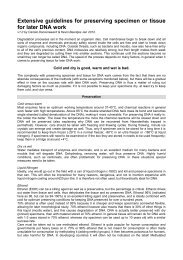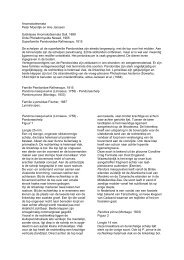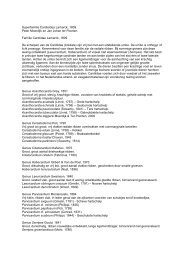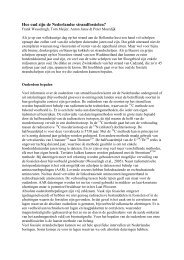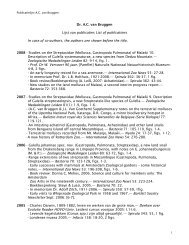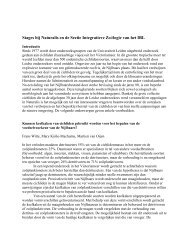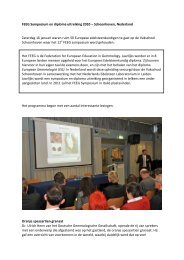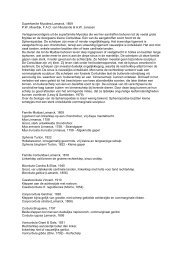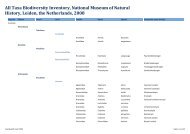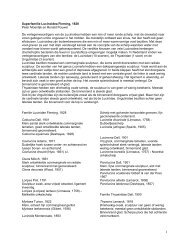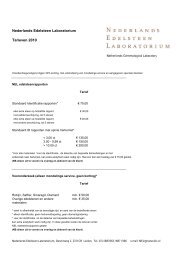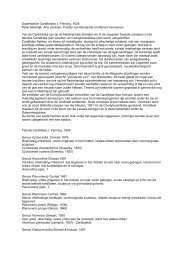The Odonata of Sulawesi and adjacent islands ... - science . naturalis
The Odonata of Sulawesi and adjacent islands ... - science . naturalis
The Odonata of Sulawesi and adjacent islands ... - science . naturalis
Create successful ePaper yourself
Turn your PDF publications into a flip-book with our unique Google optimized e-Paper software.
Libellago <strong>and</strong> Sclerocypha <strong>of</strong> <strong>Sulawesi</strong><br />
black. Male differs from other Libellago from <strong>Sulawesi</strong> by combination <strong>of</strong> black<br />
m<strong>and</strong>ibles <strong>and</strong> gena, blue markings on frons, three spots on posterior lobe <strong>of</strong> pronotum,<br />
red dorsum <strong>of</strong> abdomen; L. c. celebensis <strong>and</strong> L. c. dorsonigra have no pale<br />
markings on frons, while these markings <strong>of</strong> L. rufescens are yellow. Differs from<br />
L. c. anoa by its three pale markings on posterior lobe <strong>of</strong> pronotum, rather than a<br />
transversal stripe, <strong>and</strong> a wide <strong>and</strong> bluish stripe on mesepisternum, rather than a narrow<br />
yellow stripe, <strong>and</strong> by mostly red ventral parts <strong>of</strong> the abdominal tergites (black<br />
in L. celebensis anoa).<br />
Description <strong>of</strong> holotype male<br />
Head: Labium with base <strong>of</strong> median lobe dirty white, remainder black; m<strong>and</strong>ibles, labrum,<br />
gena, clypeus black, all parts except postclypeus shining; frons with paired<br />
blue spots, anteriorly irregular <strong>and</strong> separated by nearly the width <strong>of</strong> one spot, continued<br />
on dorsum <strong>of</strong> head between antennae, here nearly touching, rest <strong>of</strong> head mattblack,<br />
two suboval bluish white postocular spots (Fig. 2d), occiput black.<br />
Thorax: Pronotum (Figs 3d, 4d) black with bluish white markings as follows: anterior<br />
lobe with long <strong>and</strong> wide transverse marking; median lobe with large pale triangular<br />
markings adjoining lateral lobes, pointed anteriorly; lateral lobes black without<br />
pale markings; posterior lobe laterally with a triangular spot at each corner, <strong>and</strong> a<br />
short transverse median stripe. — Synthorax (Fig. 5d): mesepisternum with bluish<br />
marking anteriorly wide, distinctly narrowed in posterior half, posteriorly acute;<br />
suboval spot in posterior corner <strong>of</strong> mesepisternum close to mesopleural suture; mesokatepisternum<br />
black; mesepimeron black, except for a small elongate marking in<br />
posterior quarter near mesopleural suture; metepisternum with prominent yellowish<br />
marking, covering virtually complete anterior half except area around metastigma;<br />
a small squarish dorsal emargination halfway, ventrally broadly emarginate in posterior<br />
two-fifths; metepimeron with yellow marking in ventro-posterior corner. —<br />
Legs black, some pruinosity. — Wings long <strong>and</strong> narrow, Fw with opaque brownish<br />
black tip distal to Px 11, without pterostigma, Hw clear, with oblong pterostigma<br />
near wing tip, other characters as for genus.<br />
Abdomen: Scarlet red, but S1 <strong>and</strong> anterior part <strong>of</strong> ventral side more yellowish red,<br />
intersegmental annulae bordered black; ventral sides <strong>of</strong> S1, S2 <strong>and</strong> S10, <strong>and</strong> all sternites,<br />
black; anal appendages black.<br />
Measurements [mm]: Abdomen 21; Hw 25.<br />
Description <strong>of</strong> female<br />
Head: Pale markings yellowish white, some parts with bluish tinge, distinctly more<br />
extensive than in male; labium with base <strong>of</strong> median lobe pale, m<strong>and</strong>ibles <strong>and</strong> gena<br />
pale; clypeus black, except for a paired small spot in lateral corner <strong>of</strong> postclypeus<br />
near frons; anterior side <strong>of</strong> base <strong>of</strong> antenna pale; frons with paired subrectangular<br />
marking, somewhat extended in latero-anterior corner, posteriorly continued on head<br />
to level <strong>of</strong> posterior side <strong>of</strong> median ocellus; rest <strong>of</strong> head matt-black with oval postocular<br />
spots. Antenna black, except anterior side <strong>of</strong> base.<br />
Thorax: Markings yellowish white, but shape very similar to those <strong>of</strong> male; median<br />
marking <strong>of</strong> posterior lobe <strong>of</strong> pronotum smaller than in male, or absent. Legs black,<br />
but mostly more pruinose than in male. Wings as in male, but pterostigma in both<br />
Fw <strong>and</strong> Hw, no dark marking in Fw.<br />
International Journal <strong>of</strong> Odonatology 10 (2) 2007: 209-248, pls II, III<br />
229



